Difficult conversations about the important issues of elephant conservation were made a whole lot easier for St Jude’s ‘Tembo club’ recently, when elephants strayed into the school campus.
“We have a situation, there are some visitors at the school grounds, they’re elephants!”
These are the words the Head Guard of Smith Secondary Campus, Joseph, never thought he would relay to school management, but this year students and staff didn’t have to go on safari to get close to the majestic animals.
The herd had in fact entered the school through a gap in the boundary wall that had succumbed to last year’s heavy rains. The temporary wire fence put in its place while repairs are underway proved an easily conquerable obstacle to these determined, yet gentle, giants.
“I first heard the sound of elephants, or tembos as we call them in Swahili, trumpeting and went to investigate. They were peacefully moving through the campus, causing no damage. It seemed they were trying to get back to the nearby Arusha National Park,” Guard Joseph explained, his surprise evident.
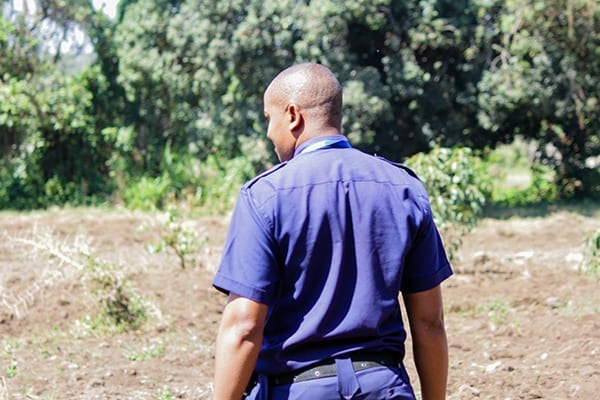
Members of the St Jude’s Tembo Club, advocates for the conservation of the elephant and rhino, were among the curious crowd of spectators and played an important role in keeping students calm, while observing the endangered species.
“I was brushing my shoes ready for Sunday mass, and I thought my eyes were playing tricks on me! There is no way I am seeing elephants on campus I thought. Tembo Club members helped keep students at a safe distance and were able to answer questions because of what we have learnt through our involvement with the club,” Form 6 student and Tembo Club member, Kevin, recalled.
With the help of park rangers and nearby residents, the elephants were herded from campus and safely arrived in the National Park two days later.
From that day the unexpected visitors have sent the St Jude’s Tembo Club into the spotlight. 30 committed students, ranging from Form 2 to Form 6 have been hard at work raising awareness about the animals that sadly face extinction as targets of ivory poachers.
“I have a passion to volunteer and make society aware of these animals. Elephants have many advantages, they are a tourist attraction and that leads to employment and being proud of our country. Many elephants are wrongly killed as many people are in search of their tusks,” Tembo Club member, Nasra, shared.
Now, thanks to the continued support of American Friends of St Jude’s and contributions from the Elephant Cooperation, the Tembo Club is set to have its biggest year yet.
With guidance from teachers with a background in animal science and biodiversity, club members have an opportunity to learn about the animals as well as the complicated relationship that has evolved living in such close proximity to people.
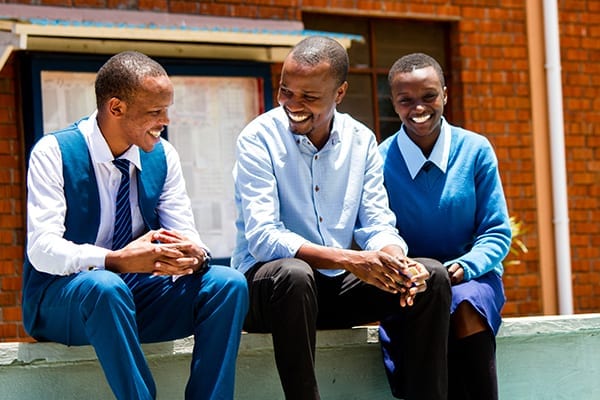
“We were able to follow up on the elephants in this area and their habits and found that years back there were elephants who roamed the area we now call Smith Secondary Campus. Elephants are smart animals so we think these were actually tracing their ancestor’s routes,” Tembo Club teacher John clarified.
The roots of the club have even branched out to the community. Catherine and Christina, St Jude’s graduates now in their Community Service Year with the Beyond St Jude’s program, held a Tembo Club meeting at a local government school which more than 40 students attended.
“Some people think that conducting the ivory black market is a good thing because they can get furniture. It’s a disappointment that these views are still held even today. Poaching means we destroy natural resources that are beneficial to us. The elephants’ visit to Smith Secondary Campus has only reinforced the importance of Tembo Club to the community,” former Tembo Club President, Christina shared.
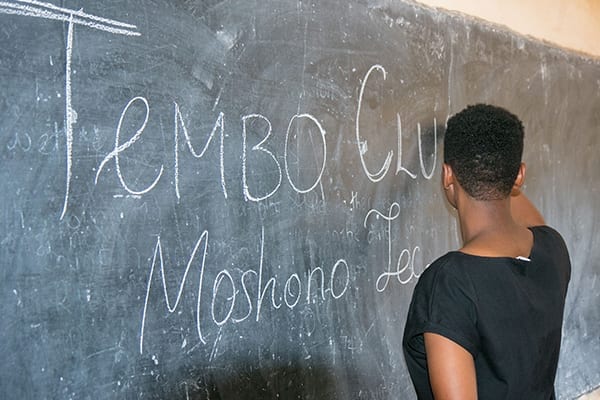
Meaning while the tembos may have left our secondary campus, the message of their conservation is travelling with them outside the school gates, helped along by a group of impassioned St Jude’s students, known as the Tembo Club.
Help our students explore their passions in extracurricular clubs by donating today.
Wide eyed Form 2 student, Marium, came within meters of a buffalo, a herbivore regarded as one of the most dangerous animals in Africa.
From the safety of a St Jude's school bus, she was seeing her biology and geography classes come to life in the heart of one of Tanzania's renowned national parks, the Arusha National Park.
'My heart was pumping, we had been learning in class the difference between female and male buffalo, so to be seeing them that close was something you just can't experience in the classroom. I could even see their weight, head size and type of horns, Marium excitedly shared, after the encounter.
Located just 25km from the Smith Secondary Campus, the varied national park ecosystem is literally on the doorstep for St Jude's students.

Into the field: 180 students packed out the St Jude's busses for a tour of the park.
This popular National Park is visited by keen geographers and biologists from across the world, yet many Tanzanian children don't get the chance to experience the national park that is located in their own backyard.
The School of St Jude is determined to change that, ensuring students have the opportunity to experience the unique attractions of their own country. Thanks to generous donors, all classes from primary to secondary, participate in at least one excursion trip per year.
With Mount Meru, Africa's fifth highest mountain, making for a spectacular backdrop the intrigued students quizzed the guides about the rare colubus monkeys playing in the canopies above and the grazing zebra herds.
'I did not know there are different types of zebra and we were shown them all here in Arusha National Park, Marium reflected.
The excursion was also about educating the 180 Form 2 students on the threats facing the animals of their homeland.
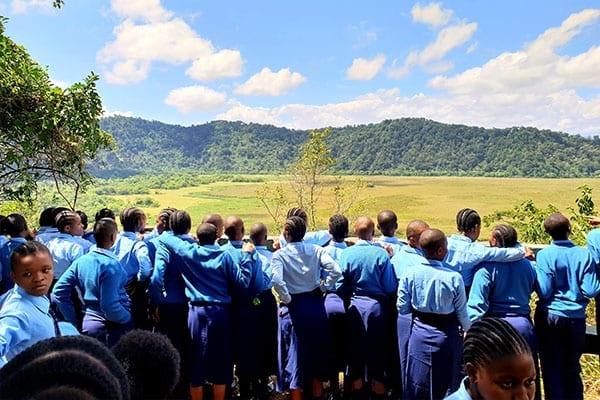
Classes come to life: Students are taught about the geography of the parks, thanks to qualified guides.
'Animal poaching has been in the news recently and coming to the park we have learnt how we can help stop that. I have learnt how animals depend on each other in the wild. Mama Gemma [referring to Founder, Gemma Sisia] was smart to make the Arusha National Park our extended backyard; I now want to protect it. Instead of just writing in the class, you can see it practically with your own eyes," Form 2 student, Andrea, explained while exploring the dense forest.
It's this experience of being able to relate theory to the real world that is the goal of taking students on this kind of excursion, Head of Geography, Mr Elimringi, said.
'In classes we can really only guide students on theory, so once we expose them to these trips they can interpret the theory in a whole new way. We find these trips often make students more interested and engaged with the subjects, he shared while watching students explore the wetlands.
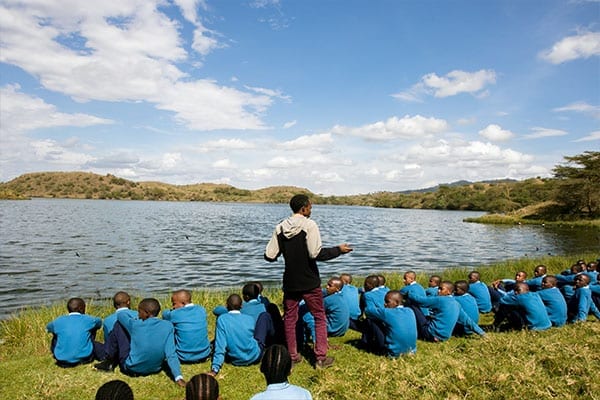
Outdoor classroom: Head of Geography, Mr Elimringi, briefs students about how their classroom learning relates to the world around them.
When it came time for Marium and her classmates to leave the ranging buffalo herd in their natural habitat, they departed having put their learning into context in one very varied and internationally-renowned classroom.
Help our students learn and explore on excursions outside the classroom. Donate today.
As the St Jude’s Smith Secondary Campus became a bustling exhibition for the annual Science Day, there were some new demonstrators delighted to be part of the much anticipated event. For the first time in the exhibitions’ nine-year history, St Jude’s graduates now teaching at under-resourced government schools as part of the Beyond St Jude’s program, brought their students to demonstrate their hard work.
This collaboration is one of the ways our graduates are giving back to the community through their Community Service Year before going on to higher education.
Njiro Secondary School student, Emmanuel John, presented an impressive environmentally friendly car powered by solar panels and a remote control, with the help of his teacher and St Jude’s graduate, Nembris.
“The direction of the car is created through positive and negative charges. This car has many advantages as it can be sent into remote areas where humans can’t go. They can control it from a distance. It can also be used in our National Parks to protect them and replace cars that are using fuel,” Emmanuel John proudly informed a crowd of students.
This entry caught the eye of the exhibition judges too, with Emmanuel’s project winning the inaugural government school category and Emmanuel receiving a donation to help expand his idea.
But the judges job didn’t stop there. The annual exhibition has traditionally been the birthplace of some of East Africa’s most prominent youth innovations and this year did not disappoint.
“We have had lots of success in our Science Department on a national level and I expect we can have more. Science is growing at the school. We placed 1st and 2nd in the country over the last two years in Tanzania’s Young Scientist Competition. Students are doing projects from the topics they are studying in class,” Acting Science Deputy, Elibariki, explained while judging the projects.
The competition was fierce in the main exhibition categories, with many lab-coated students focusing on environmentally friendly innovations.
Form 4 students, John and Steven, were the overall winners with their creation of a digital home optimization system that works as a wireless security system.
“We are passionate in electronics and gaming. We want to see technology advanced in Tanzania. The project includes automation, a security system and a digital system,” said John bursting with pride, as he and his team accepted their certificate in front of an audience of more than 700.
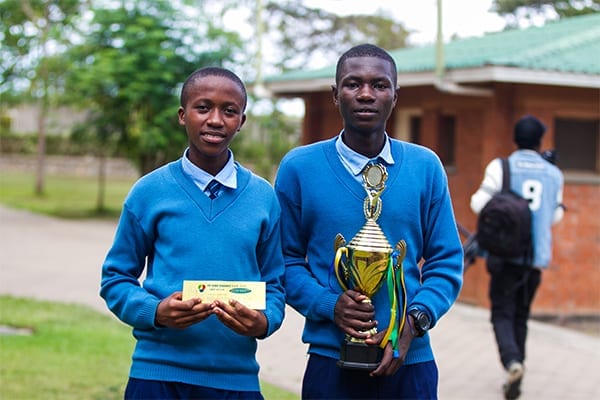
A tree planting drone, built by Form 3 students Rajab and Athuman, was named runner up with judges impressed with the practicality of the project.
“This is going to be cost effective for the Agriculture sector as we used materials like DVD cassettes to build it from scratch. We need to plant more trees to reduce the risk of global warming too,” Athuman explained while showing students his project.
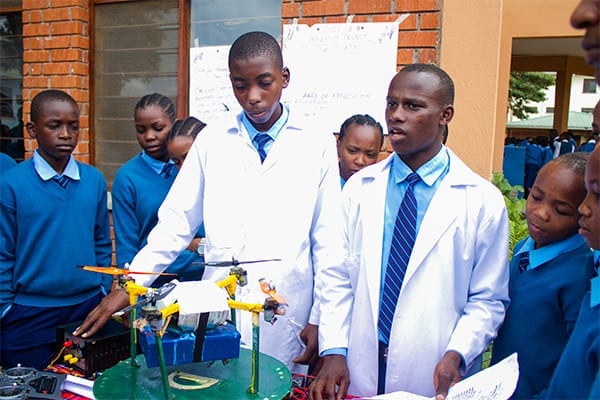
Taking third spot was Form 6 student David’s natural take on plastic, creating a biodegradable plastic alternative from natural ingredients including water, olive oil, gelatin and table salt.
“It is needed in Tanzania because plastic bags that are not decomposable have recently been banned so this is an alternative that I think could really work,” David enthused.
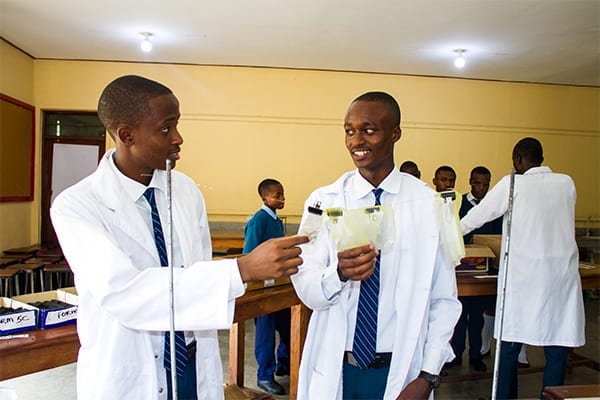
But innovation and scientific intrigue is not limited by age, with a security robot display curated by Standard 6 students another standout of the day.
“The aim of our project is making Tanzanian homes safer in an environmentally friendly way. We used wood, boxes, jugs, a bucket, solar panels and batteries. It will make an alarm if there is an intruder or if there is a fire near the home,” Standard 7 student Karen shared.
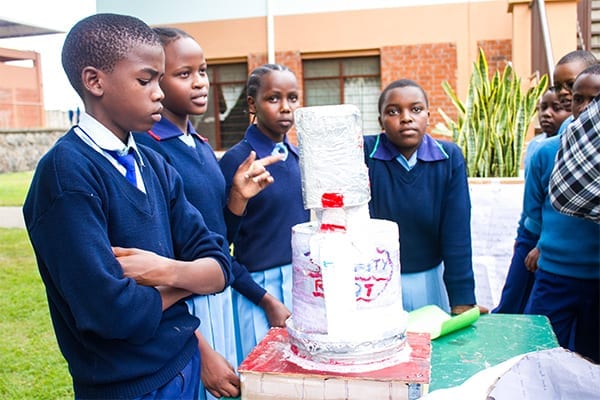
All exhibition winners now have the chance to represent St Jude’s at major events across Tanzania but the success of the day certainly spreads much further, with hundreds of students from all backgrounds and areas now inspired to study science thanks to The School of St Jude.
The 2019 Science Fair may have just discovered the next internationally acclaimed young scientist! Sponsor a student's academic scholarship and help them achieve their dreams.
As the lunchtime bell rings, Mr Mcharo concludes his Form 1 physics lesson by confirming homework with students and ensuring all curriculum topics have been covered.
Then, during the short walk to his office, he begins taking calls from students' parents, stopping to answer questions from his team of teachers and replying to urgent emails on his phone.
This is the daily routine for the passionate Headmaster of St Jude’s Smith Secondary Campus, who still teaches one class per week, while working tirelessly to lead the school to the top.
“I want our school to be in Tanzania’s top five, that’s what brings me to work each morning. I am proud of the model of education we offer our students. If you visit the homes of where these students come from, you see why it is important to support them,” Mr Mcharo states, finally taking a seat in his office.

The journey to the Headmaster’s office was not a conventional one for this proud Tanzanian. After a career in telecommunications, the 2009 economic recession saw him leave his job to return to teaching, which he studied year’s earlier.
“I remember I brought my St Jude’s application to the gate and was told to leave it there. Happily, I was called for an interview for the only available role at the time, a physical education teaching role. I loved playing football but it was a big challenge for me to train younger students in the primary school. I almost gave up but now, on the 9th of June 2019, I will be ten years at the school and I have no regrets,” Mr Mcharo reflects.
After a position became available, he returned to teaching his real love, science, and his leadership potential was quickly spotted by the then academic manager.

From a Homeroom Teacher, Level Coordinator and then a Head of Department, Mr Mcharo quickly progressed up the ranks and was finally offered the top job.
“I never thought I would be Headmaster and at the start it wasn’t even a position I wanted. But I gradually became really inspired to be in the academic office, I suppose once I’d started to think in that direction it happened quicker than I even imagined. I was only Academic Deputy for a short time before I was promoted to Secondary Headmaster,” Mr Mcharo says with surprise.
Through his rise to the top office Mr Mcharo credits one project in particular for his success, Science Day, an event becoming more embedded in the school each year.
“As a teacher I feel very proud of our science fair, I designed the logo and we had our first science fair without all the technology we know today. I think that through this project I started making a name for myself, and though I now have less involvement in the details of the event, it is still one of my favourite days in the academic calendar. It made a mark in this school because it has given many students opportunities in national and international science competitions and reinforces the concept of learning by doing,” Mr Mcharo smiled, proudly holding the very first Science Day flyer.
But since taking over the top job Mr Mcharo’s legacy has grown beyond the science fair. Under his watch the school’s academic results have been markedly improving, with Mr Mcharo leading a team that are creating an environment that truly fosters students' growth.
“Our recent A Level and Form 2 results show we are making progress, but I have a lot of ambition for where I’d like us to get to. I don’t get upset for too long if things don’t initially go quite to plan as I don’t want grey hairs at this stage! Every day I do check on our statistics and make sure we are getting closer to the goal of being one of Tanzania’s top five schools.”

Plans to introduce Agriculture into the curriculum is something else that’s close to this headmaster’s heart.
“I am looking forward to introducing Agriculture as a lesson in the school, as our society depends on agriculture and this subject will give our students another good base. We have the advantage of having our school farm with a stream of water going through the campus grounds. We can do theory classes and then use our practical space.”
That forward-thinking, the diversity and unpredictable nature of the job, along with the meetings and the emails, is what continues to motivate this esteemed physics teacher.
“As a Headmaster there are more meetings than you can schedule, so many things to be aware of, but I am still a teacher at heart and being in a classroom brings flavour to my week. The students are fun and they remind me why I am here. I like the school environment, it’s frenetic and you actually interact with people. Every day I make sure I get out from behind my desk.”
“I hope in another five years we would have hit that goal of being one of Tanzania’s top five schools and maintaining that position. I’ll have students who I taught in Form 1 graduating from university studies and then I will be able to see how I have really helped change their future,” Mr Mcharo revealed.

All the while the school’s aim of fighting poverty through education is never far from Mr Mcharo’s mind and heart.
“I still visit students’ homes. I remember I went to one student’s home and I was very tired. They didn’t have a couch so I sat on the ground, looked up, and they had a torn roof. That touched me and will always stay with me.”
Help Mr Mcharo achieve his vision for The School of St Jude by making a donation.
Down a small, windy dirt road in Sakina, Arusha's booming industrial area, the buzz of machinery and the smell of fresh wood filled the air.
The latest requirement for The School of St Jude, new chapel pews, are being constructed by local carpenters employed thanks to the school's investment in the local community.
Sam's Workshop is one of the local fundis (the Swahili word for tradesmen) who benefit from the 'ripple effects' of the day to day running of St Jude's. They build and repair the hundreds of desks, benches and equipment needed to operate the primary and secondary campuses.
'By having business from St Jude's I am able to employ extra local guys and it gives us work, company owner Sam proudly said, while examining the work.
It is estimated 70% of Tanzanian's live on less than AUS$2.50 a day, meaning every job makes a difference.
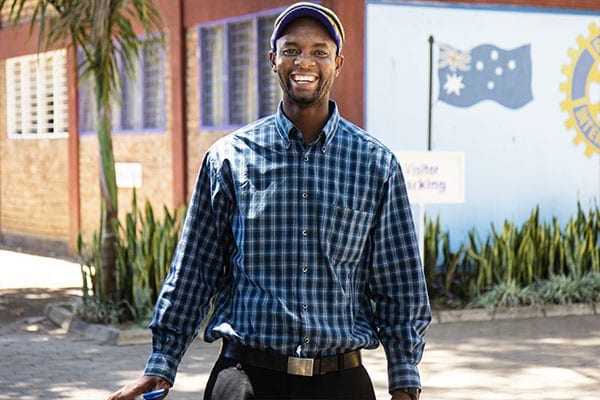
Economic Impact: Head of Maintenance and Facilities, Amani, is proud to give back to the Arusha community through local employment & investment.
Amani, Head of Maintenance and Facilities at St Jude's, explained that as the school continues to grow, so too does the positive impact on the local Arusha economy. By choosing to buy local over purchasing from a larger city like Dar es Saalam or importing from Nairobi St Jude's is ensuring that we impact many more families than just those of our students.
Last year, St Jude's injected over AUS$6 million into the East African economy, predominately in Arusha. That's made up of everything it takes to keep a school the size of St Jude's running day in and day out, from desks, books and computers to food and uniforms, right through to wages for staff.
'A lot of work goes to the local community. We pay fundis, tailors and others and we are buying materials and produce from local people. Local manufacturers and contractors are cheaper than imports because they are not including transport costs. They are thankful for the business, Amani shared with a smile.
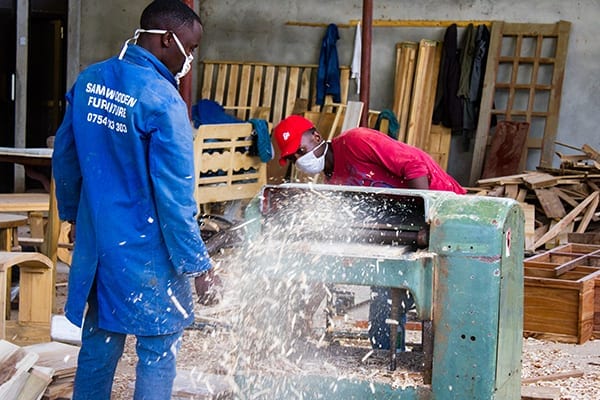
Jobs boost: Tradesman work on the school's new chapel pews at Sam's Workshop.
St Jude's is also at the heart of the community according to the swathe of farmers and shop owners who deliver produce to the school's hardworking cooks each day.
Head Chef at Moshono Primary Campus, Julius, estimated the school spends more than AUS$7,900 at the market each week, buying food needed to feed the 1,800 hungry students.
'The farmers and local shop keepers tell me regularly that they are very thankful for the existence of the school as it brings them more business. We order good quality produce to give the students nutritious foods - making sure they have fruit every day means buying over 600 bananas a day! We buy local to boost the economy of the Arusha region, he divulged while sorting tomatoes for that day's lunch.
The ripple effect continues through to Arusha's bustling central market, reaching Double Door Textiles who provide the fabrics for all the students' school uniforms.
'I love doing business with St Jude's. This year I am providing over 40 rolls of fabric just for the secondary students' school uniforms. They are one of my top clients because of the quantity required to support the school and they ask for quality material that lasts, Double Door Owner, Amer Nassor commented.
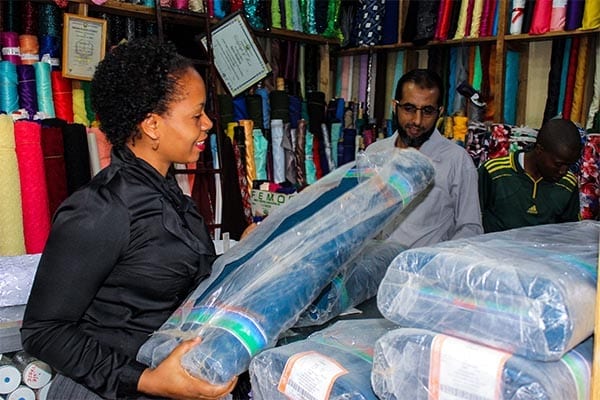
Major order: Purchasing Assistant, Grace, picks up school uniform materials from Double Door Textiles in Arusha town.
His team are hard at work sourcing materials for the influx of new Form 5 students needing uniforms in June.
'I feel very proud when I see the students in the school uniform and also when I heard the Founder, Gemma, was happy with the quality of the fabrics, Amer smiled resting on a pile of colorful textiles.
The uniform is an important part of starting school life at St Jude's, receiving it is often when it truly becomes a reality for new students that they're about to begin their journey with a prestigious school. But young students, grow and their first uniform doesn't last forever, so making the uniforms is an ongoing task.
'We purchase a huge amount of fabric so that our tailors, based at Sisia Primary Campus can produce uniforms our students can be proud to wear. Our seller has been very good to us for a very long time and we have a good relationship with him, Purchasing Assistant, Grace, explained while supervising the St Jude's tailors.
So whether it's furniture, food produce, fabrics or employing local Arushins, St Jude's is not only fighting poverty through education, but is creating a ripple effect felt well beyond the campus gates.